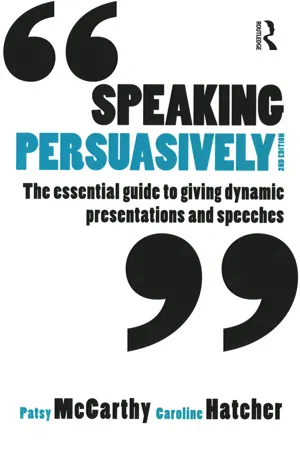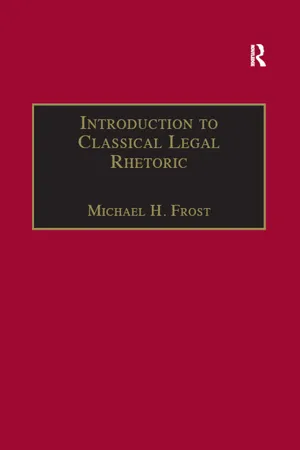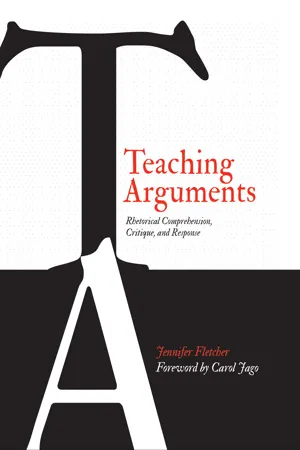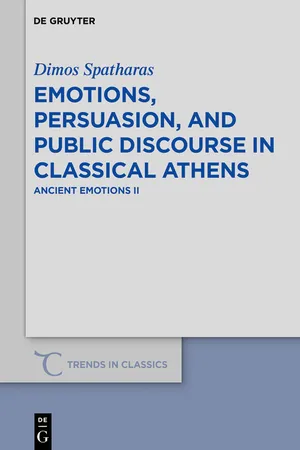Languages & Linguistics
Classical Appeals
Classical appeals refer to the persuasive strategies used in communication, particularly in rhetoric and advertising. The three main classical appeals are ethos (appeal to ethics and credibility), pathos (appeal to emotions), and logos (appeal to logic and reason). These appeals are used to influence an audience's beliefs, attitudes, and behaviors through language and communication.
Written by Perlego with AI-assistance
7 Key excerpts on "Classical Appeals"
- eBook - ePub
Speaking Persuasively
The essential guide to giving dynamic presentations and speeches
- Patsy McCarthy(Author)
- 2020(Publication Date)
- Routledge(Publisher)
rhetoric is now frequently used to criticise the way people describe their intentions, a derogatory term to suggest that intentions of the speaker are dishonest and hide the truth. However, as we have said, we believe that all attempts to describe the way ‘things really are’ rely on particular constructions of the meanings of those ‘things’. ‘Truth’ is not as clear cut a concept as we have been made to believe. Therefore, it is important for us to realise that, without being dishonest, we have the potential to construct ideas in ways which represent them to our advantage rather than disadvantage.THE PAST
Aristotle’s traditional understanding of the term rhetoric is a very useful way to approach a modern understanding of persuasion. He attempted to describe the way social influence helps individuals achieve personal goals. He perceived rhetoric as the gentle art of persuasion, a study of what it means to be persuasive in any situation. Don’t misunderstand us—Aristotle didn’t invent persuasion. It has been around since people shared their first meal and lived together as a group. What Aristotle did was to describe how persuasion works. He had a very simple formula of three proofs or appeals which are used to make messages persuasive.THE APPEALS OF ETHOS, PATHOS AND LOGOS
Ethos refers to the credibility of the speaker. It emphasises the fact that speakers are more effective as persuaders if they are believed by listeners to be credible sources. Listeners are immediately sceptical of speakers if their credibility and credentials are not readily apparent.Pathos refers to the emotional appeal made by the speaker to the listeners; it emphasises the fact that listeners respond with emotion to ideas. When citizens are asked by government to go to war in a foreign country for the sake of ‘the fatherland’ or ‘the mother country’, the dominant appeal is to pathos - eBook - ePub
Rhetorical Public Speaking
Social Influence in the Digital Age
- Nathan Crick(Author)
- 2022(Publication Date)
- Routledge(Publisher)
8 LogosDOI: 10.4324/9781003316787-8The rhetorical character of logos was present at its very origin. When citizens of Classical Greece used the word logos, it referred to words, arguments, or reason. For example, the term dissoi logoi (meaning “double arguments”) was a common phrase that referred to the Greek belief that there were always two or more arguments opposed on every issue. The Greeks acquired this belief largely because of their reliance on courts of law to decide almost any dispute. Any time two people came into conflict, their instinct was to bring this conflict into court in order to hear both sides and come to a practical judgment. In these sorts of rhetorical contexts, logos refers to the use of rational arguments and evidence to persuade an audience of the reasonableness of one’s position. It is based on the belief that human beings are rational beings with the potential to make decisions based on logic, principles, and evidence.The study of rhetoric corresponded with the study of logic, for both were grounded in the faith that human beings are rational creatures who seek reasons for their actions. Without the faith that people make better practical judgments when presented with more comprehensive and accurate facts, we would be forced to rely purely on either habit, passion, or luck. The difference between rhetoric and logic is that whereas logic examines the validity and coherence of argumentative propositions apart from the situated context of action, rhetoric is concerned with how arguments affect specific audiences in specific times and places. In addition, rhetoric does not neglect the importance of other rhetorical appeals like ethos and pathos. Rhetoricians understand that while reason plays a vital role in human decision making, it is rarely, if ever, sufficient for successful persuasion. Often, our emotions are necessary to judge right from wrong, effective from ineffective, and pleasure from pain. Likewise, our ability to discern who is a more reliable advisor during times of crisis can rarely be made by logic alone. In fact, our need to trust other people usually arises precisely when logic reaches its practical limit. The very idea of the rhetorical situation supports this conclusion—for if we had all the facts that we needed to make a decision, we would hardly need to be persuaded of anything. - eBook - ePub
Introduction to Classical Legal Rhetoric
A Lost Heritage
- Michael H. Frost(Author)
- 2017(Publication Date)
- Routledge(Publisher)
They too urge lawyers to exploit the audience’s emotions strategically, depending on what stage of the trial (voir dire, opening statement, closing argument, etc.) is taking place. The modern tolerance of emotion’s place in persuasive discourse represents the biggest difference between classical and modern approaches. In part, this tolerance springs from modern experts’ conviction that most people reason in an affective (emotional, symbol-oriented), rather than a cognitive, fashion. In addition, modern experts stress the overlapping effects of emotion and lawyer credibility in ways that differ from the classical sources. SIMILARITIES AND DIFFERENCES In their systematic and comprehensive analysis of legal discourse, Greco-Roman rhetoricians divided legal argument into three equal and mutually dependent components: logos, pathos, and ethos. Even though they emphasized the importance of logic, they realized that judges and juries also make their decisions based on non-rational factors such as their sense of the advocate’s personal integrity or the emotional content of the case. Taking these factors into account, classical rhetoricians devoted as much attention to these non-rational means of persuasion as they did to logic. For them, advocacy was an art and could only be learned by practice. Using examples drawn from their own considerable experience, they emphasized audience assessment techniques, strategic approaches, recurring problems, and the importance of flexibility. Above all, they stressed the importance of projecting the advocate’s personal integrity and exploiting the emotional climate of the case. Their overall approach was focused on humanizing the case in ways that would favorably affect the judge’s decision. Modern analysts, especially trial advocacy specialists, also realize the importance of ethos and pathos in persuasive discourse - eBook - ePub
Common Core Reading Lessons
Pairing Literary and Nonfiction Texts to Promote Deeper Understanding
- Stacey O'Reilly, Angie Stooksbury(Authors)
- 2013(Publication Date)
- Routledge(Publisher)
Rhetoric. Rhetoric? Simply defined, rhetoric is the way we use language to write or speak effectively. Convincing others and defending what we believe is an integral part of navigating daily life. Students must be taught to appreciate rhetoric and the many ways it can impact the outcome of getting what they want. Depending upon the age of the student and the previous exposure to rhetoric, you may find yourself beginning with the basic rhetorical question. Start by asking students some of the cliché questions that they may have heard and been too quick to answer. Some possibilities are “If your friend jumped off a bridge, would you jump too?” “How am I supposed to live without you?” “Aren’t you ashamed of yourself?” “What business is it of yours?” “Why me?” Students may laugh, but many will admit to getting into trouble for answering these questions or for “talking back.” Teaching students that some questions are not meant to be answered verbally introduces them to the idea that rhetoric forces them to play a game. Questions are used to promote thought and emphasize points. Part of the art of rhetoric is listening to what is being said and how it is being said in order to understand your next move.Rhetoric
Rhetoric is the way we use language to write or speak effectively.Ethos, Pathos, and Logos
We acknowledge the importance of rhetoric but can find ourselves, and our students, overwhelmed by the endless possibilities. To achieve a small, capable plan of attack we approach rhetoric through ethos, pathos, and logos. Ethos is the credibility, character, and competence of the speaker. Pathos is the emotional appeal of the speaker. Logos is the facts, statistics, and logical appeals the speaker makes. Ethos, pathos, and logos are essential tools in reaching an audience when woven together in the right doses based upon the composition of the audience.Ethos, Pathos, and Logos
- Ethos is the credibility, character, and competence of the speaker.
- Pathos is the emotional appeal of the speaker.
- Logos is the facts, statistics, and logical appeals the speaker makes.
An Example of Breaking It Down
Ethos
Let's break it down. Students must consider where the information is coming from and adequately evaluate the source. There is no magic formula for calculating ethos here; a list of initials following a name does not always make a person credible. For example, a doctor of sociology speaking at a symposium to raise awareness on issues plaguing the homeless population in the United States will have studied, gathered research, and interpreted the data, perhaps even spent years detailing his conclusions in writing. Based upon our reflection of his credentials and life's work, we find him to be a credible resource. Another speaker at the symposium is a former homeless transient with a general equivalency diploma (GED) who spent more than 20 years living on the streets across the United States. At first glance, the audience might admire his ability to turn his life around while overlooking his credibility. But, if you think about it, he has lived the life that the researcher has only studied. His experience is no less valid than that of the doctor, and his brings an aspect that the doctor can’t provide. Students need to see that both of these men are essential to the program because combined they provide the scope and depth to truly understand the issue. - eBook - ePub
Preaching the New Testament as Rhetoric
The Promise of Rhetorical Criticism for Expository Preaching
- MacBride(Author)
- 2014(Publication Date)
- Wipf and Stock(Publisher)
7Pathos : Appealing to the Emotions
Having looked at ethos , we now turn to the next proof in Aristotle’s triad, that of pathos . As noted in chapter 5, pathos arguments are those which put “the hearer into a certain frame of mind”586 according to Aristotle, and by the time of Cicero and Quintilian had developed into an appeal to the more “violent” emotions, as opposed to the “milder” ones associated with ethos .587 This chapter will thus investigate the use of pathos arguments in ancient rhetoric, looking at what pathos appeals were attempting to achieve in terms of rhetorical strategy, and how such appeals were constructed. At each point we will note how this relates to Paul’s use of emotional appeal, and implications for how we might preach from such arguments today.Identifying pathosTo begin with, however, we must attend to some issues of method, the first of which is whether we should expect to find much in the way of pathos argumentation in Paul’s epistles. Despite much of the handbooks’ discussion of pathos being located primarily in the context of forensic rhetoric—how one might emotionally influence the judge—this is by no means the only situation in which it was employed. For example, the writer to Alexander explicitly includes emotional appeals in his discussion of deliberative rhetoric.588 An analysis of actual speeches yields significantly more evidence, leading Carey to conclude from his extensive investigation that pathos is equally “at home in deliberative oratory.”589 Therefore it is likely that Paul followed the conventions of his time, as he does with many other aspects of rhetorical theory and practice.Further evidence that Paul quite consciously employed pathos strategies is found in an intriguing passage of 2 Corinthians (7:5–13). Here, Paul hints at how the “painful letter” was intended to function rhetorically, explicitly referring to the emotions that will prompt action, namely, repentance (2 Cor 7:10, “For godly grief produces a repentance that leads to salvation and brings no regret”). Kraftchik comments that “it is the appeal to the emotions that produced the results Paul had initially sought [in 1 Corinthians]. Hence, though it pained him to write it, he did not regret doing so.”590 Kraftchik goes on to conclude both from the stress placed on emotional appeals by theorists such as Aristotle and Cicero, as well as from Paul’s explicit acknowledgement of the role of emotions in producing action, that it is likely “Paul will also use pathos- based appeals in his other letters.”591 - eBook - ePub
Teaching Arguments
Rhetorical Comprehension, Critique, and Response
- Jennifer Fletcher(Author)
- 2023(Publication Date)
- Routledge(Publisher)
Chapter 1 ). This proof might be “hard” or “soft,” depending on the academic discipline and task, but chances are most of the arguments high school students make and read aim for reasonable conclusions rather than absolute certainties. In “Three Ways to Persuade,” John Edlund describes how we both favor and fudge logic in most twenty-first-century arguments:In our society, logic and rationality are highly valued and this type of persuasive strategy is usually privileged over appeals to the character of the speaker or to the emotions of the audience. However, formal logic and scientific reasoning are usually not appropriate for general audiences, so we must rely on a more rhetorical type of reasoning. (2013, 56)A rhetorical type of reasoning allows writers to apply principles of logic even when the truth can’t be known. These principles include supporting claims with evidence, responding to counterarguments, qualifying assertions, examining assumptions, avoiding fallacies, connecting ideas, and in general making a good faith effort to be sensible. The goal is an argument that is reasonable and defensible, not an airtight case.AsEdlund (2013)notes, there’s a tradition of privileging logos over the other rhetorical appeals dating back to Aristotle. Given his druthers, Aristotle prefers that all arguments rest on logical proofs, but he also recognizes that knowing something is not the same as caring about it—hence the need for pathos.George Hillocks follows this tradition when he calls logical appeals “the essence of argument” (2011, xvii). The CCSS also shows a preference for logic and rationality. Notice how the following ELA writing standards for grades nine and ten are full of the language of logos: - eBook - ePub
Emotions, persuasion, and public discourse in classical Athens
Ancient Emotions II
- Dimos Spatharas(Author)
- 2019(Publication Date)
- De Gruyter(Publisher)
chapter 4 offers a general discussion of the ideological uses of (what I call) ‘legitimate envy’ in democratic Athens, but also explores the ways in which Demosthenes invests with salience Meidias’ excessive lifestyle, thereby constructing emotion scripts of ‘indignation’. This section outlines methodological aspects pertaining to the interfaces between vision, emotions, and persuasion.Quite naturally, students of ancient oratory and rhetoric usually lay stress on verbal means of persuasion, thereby engaging in analysis and classification of speakers’ arguments. This logocentric approach to the surviving speeches has benefited in recent years from cognitive, appraisal-oriented approaches to emotions.15 Indeed, Aristotle’s Rhetoric , a treatise that has been tremendously influential in ancient and modern times, introduces what modern psychologists call cognitive approach to emotions or appraisal theory.16 A pioneering scholar in the field of cognitive psychology, Richard Lazarus (2001: 40), has pointed out, that “[T]hose who favor a cognitive-mediational approach must also recognize that Aristotle's Rhetoric more than two thousand years ago applied this kind of approach to a number of emotions in terms that seem remarkably modern”. Lazarus’ point about psychologists’ belated realization that cognitive approaches to emotions can be traced back to Aristotle also holds true in classicists’ study of pathopoiia . As I argue below, commonsensical approaches to speech’s pathopoiia commonly fail to explain how speakers’ ‘appeals to emotion’ operate to achieve persuasion.17 Notably, in his Rhetoric Aristotle deplores handbooks’ treatment of passions (and, in the same context, diabole –indeed, not a pathos 1354a 16–17), because they fall short of an adequate explanation of how pathe enhance rational types of proofs –the real object of rhetoric.18In spite of the fact that cognitive analysis, centering on verbally expressed emotion scripts, is particularly useful for the study of emotions, the emphasis that our sources place on the psychological impact of vision, one of the most distinct means of non-verbal persuasion in Greek culture has significant implications for the ways in which visuality is deployed in oratory. But the analysis of vision’s role in persuasion transcends the limits of literary criticism. Because in many cases ancient cultural (and scientific) models of vision are different from their modern counterparts,19
Index pages curate the most relevant extracts from our library of academic textbooks. They’ve been created using an in-house natural language model (NLM), each adding context and meaning to key research topics.
Explore more topic indexes
Explore more topic indexes
1 of 6
Explore more topic indexes
1 of 4






